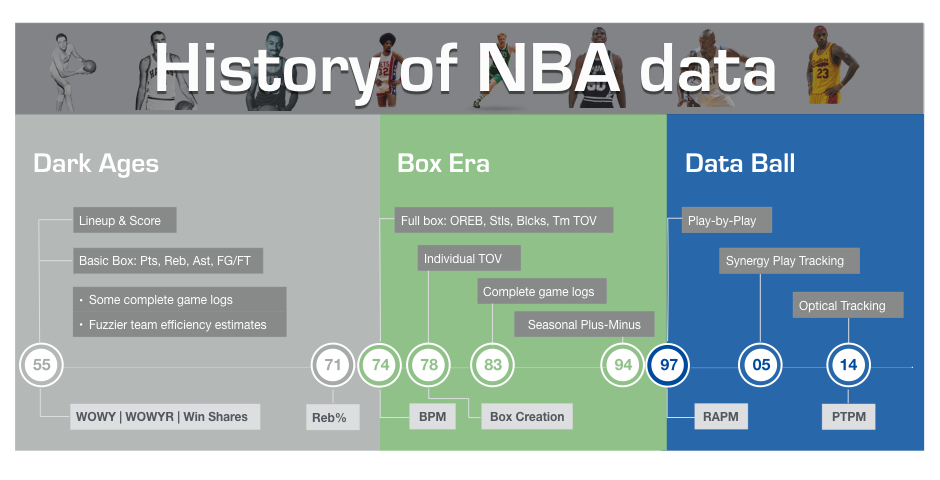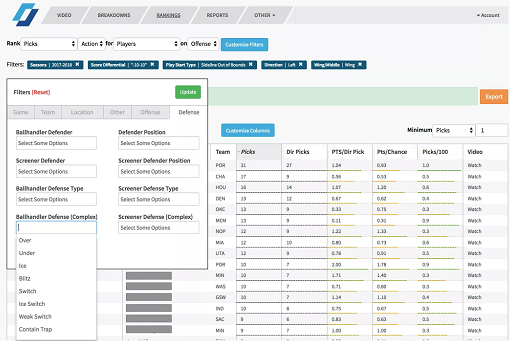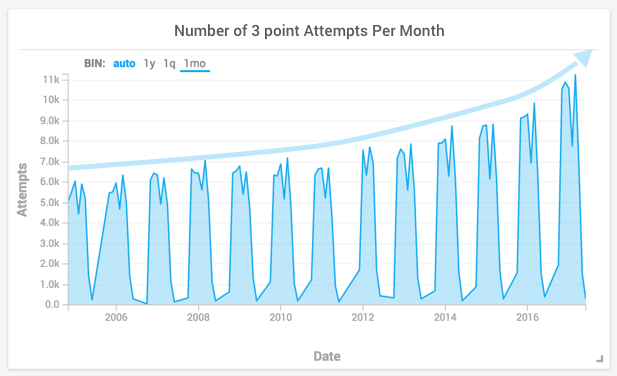Analytics in sports, also known as Moneyball, is the ability to act in the context of using data. The old school method, scouts measuring talent by watching, a.k.a. the “eye-test” didn’t die. But now it should have gained an unlikely ally. And there’s no doubt; as “big data” influences decisions on and off the court, the entire basketball operations department including players, will need to adapt to the analytics.
– Where Does the Moneyball Term Come From?
– How Do NBA Teams Utilize Analytics?
– Usage of Data
– Moneyball 1.0 | Box Score & Play-by-Play Data
– Moneyball 2.0 | Video Tracking Data
– Moneyball 3.0 | Real-time Insights
– The Rise of Up-tempo Game: “Seven Seconds or Less
– Moreyball: The Three Point Revolution
– AI Revolution
– Anti-Analytics Movement
– NBA Analytics Departments
– NBA Analytics Articles
Where Does the Moneyball Term Come From?
Moneyball 1.0 is all about discovering the value of data and attempts to use it to make better decisions.Oakland Athletics general manager Billy Beane built successful baseball teams year after year, rather than relying on the gut instincts of old-time scouts, as was standard practice for decades. Writer Micheal Lewis realized another investment game was being played out in baseball, notably by the Athletics. He gained inside access to A’s general manager Billy Beane and got a look at how Beane values players differently than other teams. Oakland A’s was a low-budget MLB franchise, they attempted to employ an analytics-savvy approach to maintain a high level of success despite limited financial conditions. In 2003, Lewis wrote a book called Moneyball: The Art of Winning an Unfair Game. Oakland evaluated offensive efficiency differently than others, stressing on-base percentage and power, de-emphasizing stolen bases, and putting the ball in play. It has engendered an approach to acquiring talent-based as much on statistical achievement as on traditional tools, an approach that has gripped some franchises and galled many traditionalists.
According to Chris Herring’s “ReWind Space” (a Twitter Spaces podcast), Pat Riley has also been a believer in basketball analytics since the early 1990s. He watched game footage differently than most people. Pat was utilizing PER which he computed in 1991 for charting Knicks such as closes outs, boxouts, charges taken, and player efficacy.
How Do NBA Teams Utilize Analytics?
For the time being, all NBA teams have embraced analytics, as they employ analytics staff who directly work with or report to technical staff as well as front office executives.Analytics has been relied on for;
What Data Types Have Been Used?
 Chart courtesy of the great Backpicks.
Chart courtesy of the great Backpicks.Before the video-tracking era, analytics departments of teams were crunching numbers with tools such as StatsCube, and Synergy.
A) BOX SCORE, PLAY-BY-PLAY and SYNERGY DATA | UNTIL 2009
Dean Oliver is to the NBA what Bill James is to baseball. In 2004, he wrote “Basketball on Paper”, there were only a handful of stat-heads in NBA front offices and fans didn’t have much interest to numbers. He introduced possession-based stats and four factors with the basketball community.
In the following years, many NBA stats resources and countless blogs including NBAstuffer came in and became popular sources for statistical hoops analysis. Those websites focused on plus-minus metrics, shot efficiency and spatial analysis with the help of play-by-play data.
B) VIDEO TRACKING DATA | 2010 TO 2019
B.1.) SPORTVU, 2010-2016
In 2008, STATS has acquired SportVu, a video tracking tool which was originally developed for soccer. Basically, SportVu adds the third dimension to the traditional stats. Positioning data for all 10 players, 3 referees and the ball can be captured with 25 pictures per second. In the 2010-11 season, Dallas Mavericks, Houston Rockets, Oklahoma City Thunder, and San Antonio Spurs jumped into this technology and installed cameras. The next season, the Celtics and the Warriors were added. Starting from the 2013-14 season, NBA made SportVu cameras installed in every arena. With this move, the NBA became the first American sports league to use player tracking in every game. As a result, the amount of data exploded. Instead of stat-geeks, computer engineers and data scientists with machine learning skills have started to be targeted by NBA teams.
B.2.) SECOND SPECTRUM, 2017-Present
Starting from 2017-2018 season, the NBA switched from STATS & SportVU to Sportradar & Second Spectrum alliance.
 Screen shot courtesy of Nylon Calculus.
Screen shot courtesy of Nylon Calculus.
C)Moneyball 3.0,2019-Present
With the help of the developments in deep learning models, computer vision and natural language processing (NLP) identified and classified objects in images–better than human charting. An AI software from Statsperform (AutoStats) has enabled live video broadcasts to automatically create insights/predictions from player-tracking data as they happen.
The Rise of Up-tempo Game: “Seven Seconds or Less”
In 2004-05 season, the Suns led the league in possessions per game (averaged 98.6 pace) with Mike D’Antoni being head coach. The Suns were the clear flagship carrier of the up-tempo revolution. Fans loved the speed and the following transition 3-pointer so much that this became an NBA normal as the average pace was measured at 99.6 in 2017-18. Pelicans led the league with a 100.5 pace coached by Alvin Gentry who was also an assistant coach for Suns in 2004-05.The Three-point Revolution
One can easily suggest that the three-point shots have altered the NBA fundamentally. It is being considered a revolutionary, desirable strategy for any team in the last 10 years. Since its introduction in 1979, the efficiency of three-point shots was massively ignored. But, today each team has embraced 3P shooting so well that the average of three points taken has risen to 27 in 2017. Chart courtesy of Omni-Sci blog with the shot data provided by BigDataBall.
Chart courtesy of Omni-Sci blog with the shot data provided by BigDataBall.
Thanks to playing “Moreyball“, the Rockets leads the league in 3PT attempts per game at 44.3, which constitutes nearly the half of their total field goal attempts. The value of three-point shooting is so high that more players have started to shoot threes. For example, Mehmet Okur, a center who was good at shooting threes, attempted roughly four 3P shots per game in the 2000s. At his time, this was a huge thing. Now, there are a dozen of bigs who like to shot three.
Let's not measure the evolution only with the # of 3PT attempts. Here's a positional breakdown which reveals a trend of big guys shooting 3s. H/T https://t.co/830heAamm3 pic.twitter.com/7KwMgicvsb
— NBAstuffer (@nbastuffer) May 13, 2020
AI Revolution: How Can Teams Utilize AI
Artificial intelligence (AI) is becoming increasingly prevalent in sports analytics, with the potential to transform various aspects of the industry. AI can enhance player safety, improve scheduling, optimize advertising and ticket sales, and create more engaging broadcasts. The 2024 MIT Sloan Sports Analytics Conference highlighted the potential of generative AI to revolutionize sports:- AI can assist batters in eliminating blind spots
- AI helps create personalized content for fans of lesser-known sports
- The NFL is using AI to optimize its schedule, saving millions of dollars annually
- AI is also being used to analyze plays and identify injury risks in football
Despite the fact that AI has limitations, it is expected to continue to play a significant role in sports in the future.
Anti-Analytics Movement
Here’s a collection of NBA players who rips analytics:Crazy that in the NBA smart people are now analytic guys and not people that can visually look at a hooper and say “oh that guys good”
— kuz (@kylekuzma) July 20, 2023
- Charles Barkley
- LeBron James
- Kobe Bryant
- Zach Levine
- Kevin Durant
- Shaquille O’Neal
- Bradley Beal
- Paul George
- Josh Hart
- Isiah Thomas
- Josh Smith
- Byron Scott
- Joel Embiid
- DeMarcus Cousins
Articles Covering NBA Analytics Movement
We have put together some of the articles covering the key milestones reached, chronologically:“The no-stats all-star” written by Micheal Lewis
“Don’t deny NBA stats geeks the truth” written by Bill Simmons
“NBA dives headlong into new era of statistical analysis” written by John Schuhmann
“Player tracking transforming NBA analytics” written by Zach McCann
“Lights, Cameras, Revolution” written by Zach Lowe
“NBA embraces advanced analytics as Moneyball movement sweeps pro basketball” written by Rick Maese
“Strength of each franchise’s analytics staff” written by Kevin Pelton
“The rise of data analysis Is changing the NBA” written by Terrance Ross
“The NBA’s Adam Silver: How Analytics Is Transforming Basketball” written by Upenn
“Data analytics have made the NBA unrecognizable” written by Dan Kopf
“How to Get a Job in the NBA” written by Ben Falk
“How the NBA got its groove back” written by Kevin Pelton & Kevin Arnovitz
“Here’s How AI Will Change The World Of Sports!” written by Naveen Joshi
“A Statistical Analysis of the Overuse of Statistical Analysis in Sports” written by Ryan Callahan
“LA Clippers owner Steve Ballmer wants to save sports by reinventing the way we watch them” written by Bruce Schoenfeld
“Modern basketball debates often include one of the parties citing advanced analytics to prove their point. But are those metrics any good?” written by Bryan Kalbrosky
“How sports analytics is changing the game: ASU expert explains how data has shaped the way basketball is played written by Meenah Rincon
We try to keep this content up-to-date. Consider using the social media buttons below, or add the page URL when sharing it anywhere.
